Bibliometric Analysis of the Scientific Research of Food Industry By-Products in the Period 1976–2021
Abstract
1. Introduction
2. Data Resources and Methods
2.1. Collection of Data
2.2. Bibliometric Analyses
3. Results and Discussion
3.1. Analysis by Country, Institutions, and Subject Categories
Subject Categories
3.2. Analysis of Journals and Author Citations
3.3. Themes of Research
4. Conclusions
Limitation of the Research
Author Contributions
Funding
Institutional Review Board Statement
Informed Consent Statement
Data Availability Statement
Conflicts of Interest
References
- European Commission. Agriculture and Green Deal, Text. European Comission. 2022. Available online: https://ec.europa.eu/info/strategy/priorities-2019-2024/european-green-deal/agriculture-and-green-deal_en (accessed on 10 May 2022).
- Šubarić, D. (Ed.) Neke Mogućnosti Iskorištenja Nusproizvoda Prehrambene Industrije/Some Potentialas to Use Food Industry By-Products; Josip Juraj Strossmayer University of Osijek, Faculty of Food Technology: Osijek, Croatia, 2018. [Google Scholar]
- Hamed, I.; Ozogul, F.; Regenstein, J.M. Industrial Applications of Crustacean By-Products (Chitin, Chitosan, and Chitooligosaccharides): A Review. Trends Food Sci Technol 2016, 48, 40–50. [Google Scholar] [CrossRef]
- Barral-Martinez, M.; Fraga-Corral, M.; Garcia-Perez, P.; Simal-Gandara, J.; Prieto, M.A. Almond By-Products: Valorization for Sustainability and Competitiveness of the Industry. Foods 2021, 10, 1793. [Google Scholar] [CrossRef] [PubMed]
- Gil-Martin, E.; Forbes-Hernandez, T.; Romero, A.; Cianciosi, D.; Giampier, F.; Battino, M. Influence of the Extraction Method on the Recovery of Bioactive Phenolic Compounds from Food Industry By-Products. Food Chem. 2022, 378, 131918. [Google Scholar] [CrossRef] [PubMed]
- Taghian Dinani, S.; van der Goot, A. Challenges and Solutions of Extracting Value-Added Ingredients from Fruit and Vegetable by-Products. Crit. Rev. Food Sci. Nutr. 2022. [Google Scholar] [CrossRef] [PubMed]
- Moed, H.F. Bibliometric Indicators Reflect Publication and Management Strategies. Scientometrics 2000, 47, 323–346. [Google Scholar] [CrossRef]
- Fu, H.-Z.; Wang, M.-H.; Ho, Y.-S. Mapping of Drinking Water Research: A Bibliometric Analysis of Research Output during 1992–2011. Sci. Total Environ. 2013, 443, 757–765. [Google Scholar] [CrossRef] [PubMed]
- Singh, P.; Ojha, A.; Borthakur, A.; Singh, R.; Lahiry, D.; Tiwary, D.; Mishra, P.K. Emerging Trends in Photodegradation of Petrochemical Wastes: A Review. Environ. Sci. Pollut. Res. 2016, 23, 22340–22364. [Google Scholar] [CrossRef] [PubMed]
- Perea-Moreno, M.-A.; Sameron-Manzano, E.; Perea-Moreno, A.-J. Biomass as Renewable Energy: Worldwide Research Trends. Sustainability 2019, 11, 863. [Google Scholar] [CrossRef]
- Tirado-Kulieva, V.A.; Gutierrez-Valverde, K.S.; Villegas-Yarleque, M.; Camacho-Orbegoso, E.W.; Villegas-Aguilar, G.F. Research Trends on Mango By-Products: A Literature Review with Bibliometric Analysis. J. Food Meas. Charact. 2022, 16, 2760–2771. [Google Scholar] [CrossRef]
- de Melo, A.M.; Chaves Almeida, F.L.; de Melo Cavalcante, A.M.; Ikeda, M.; Turola Barbi, R.C.; Costa, B.P.; Hoffman Ribani, R. Garcinia Brasiliensis Fruits and Its By-Products: Antioxidant Activity, Health Effects and Future Food Industry Trends-A Bibliometric Review. Trends Food Sci. Technol. 2021, 112, 325–335. [Google Scholar] [CrossRef]
- Sabater, C.; Villamiel, M.; Montilla, A. Integral Use of Pectin-Rich by-Products in a Biorefinery Context: A Holistic Approach. Food Hydrocolloid. 2022, 128, 107564. [Google Scholar] [CrossRef]
- Shao, J.; Huang, X.; Liu, J.; Duolong, D. Characteristics and Trends in Global Olive Oil Research: A Bibliometric Analysis. Int. J. Food Sci. Technol. 2022, 57, 3311–3325. [Google Scholar] [CrossRef]
- Yeasmen, N.; Rahman Bhuiyan, M.H.; Orsat, V. Unravelling Scientific Research towards the Green Extraction of Phenolic Compounds from Leaves: A Bibliometric Analysis. Int. J. Food Sci. Technol. 2021, 56, 4893–4906. [Google Scholar] [CrossRef]
- Chen, C.; Ibekwe-SanJuan, F.; Hou, J. The Structure and Dynamics of Co-Citation Clusters: A Multiple-Perspective Co-Citation Analysis. J. Am. Soc. Inf. Sci. Technol. 2010, 61, 1386–1409. [Google Scholar] [CrossRef]
- Chen, C. Science Mapping: A Systematic Review of the Literature. Foods 2017, 2, 1–40. [Google Scholar] [CrossRef]
- Shen, C.; Wei, M.; Sheng, Y. A Bibliometric Analysis of Food Safety Governance Research from 1999 to 2019. Food Sci. Nutr. 2021, 9, 2316–2334. [Google Scholar] [CrossRef] [PubMed]
- Szajer, I. Polygalacturonase Activity of Penicillum Sp 7/4B/EI 1 Mutant Grown on Some by-Products of Food Industry. Acta Microbiol. Pol. A 1976, 8, 51–56. [Google Scholar] [PubMed]
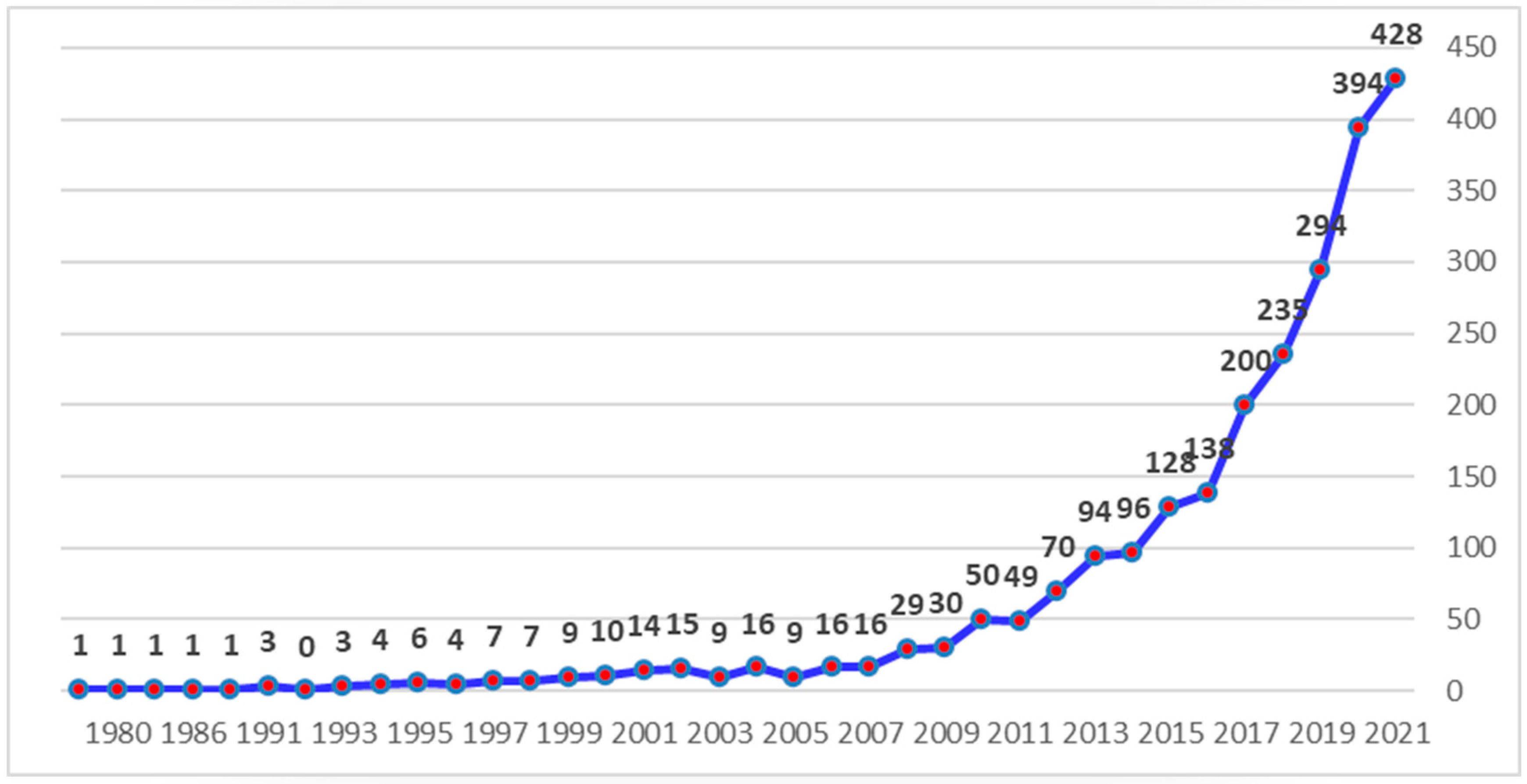
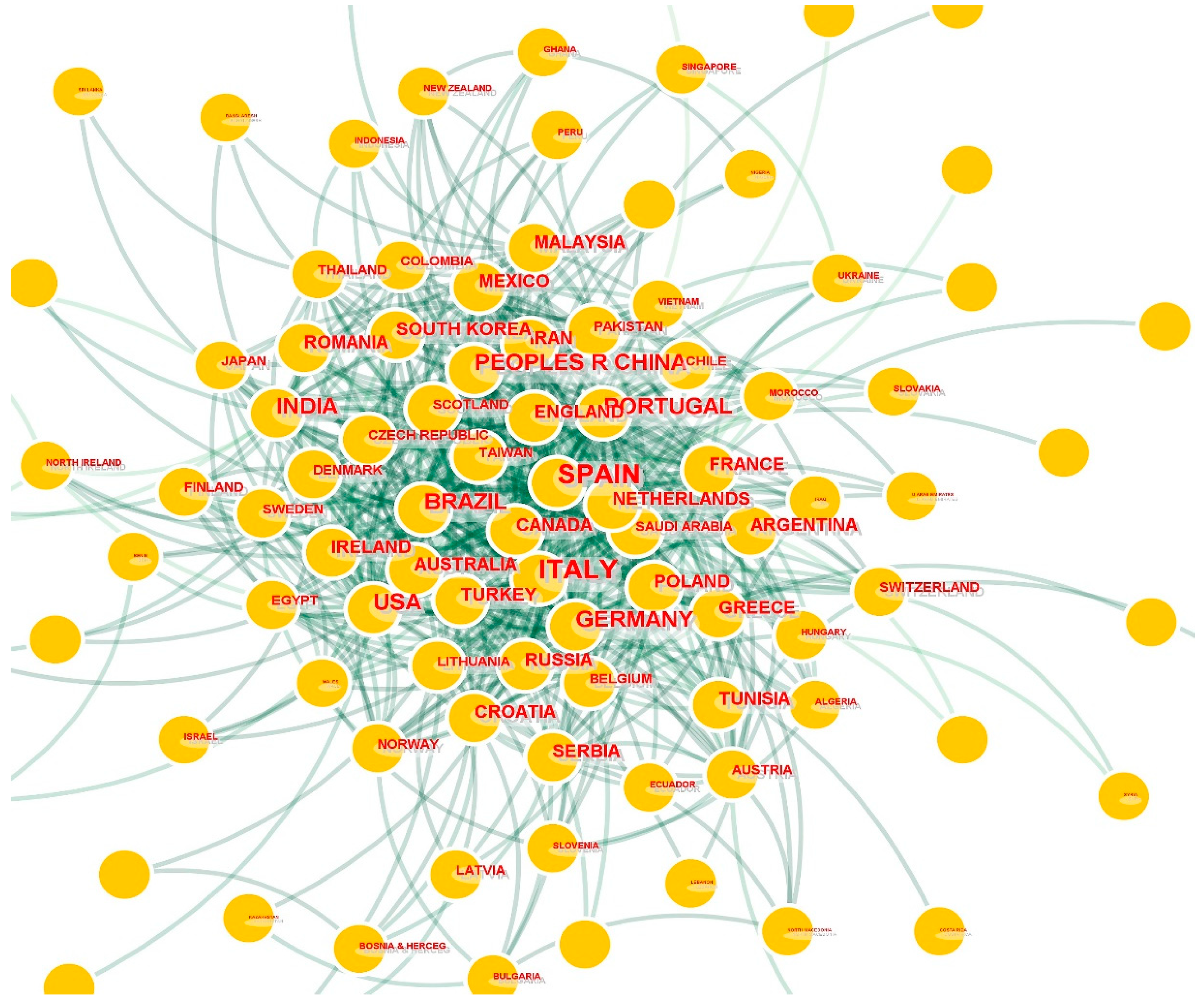
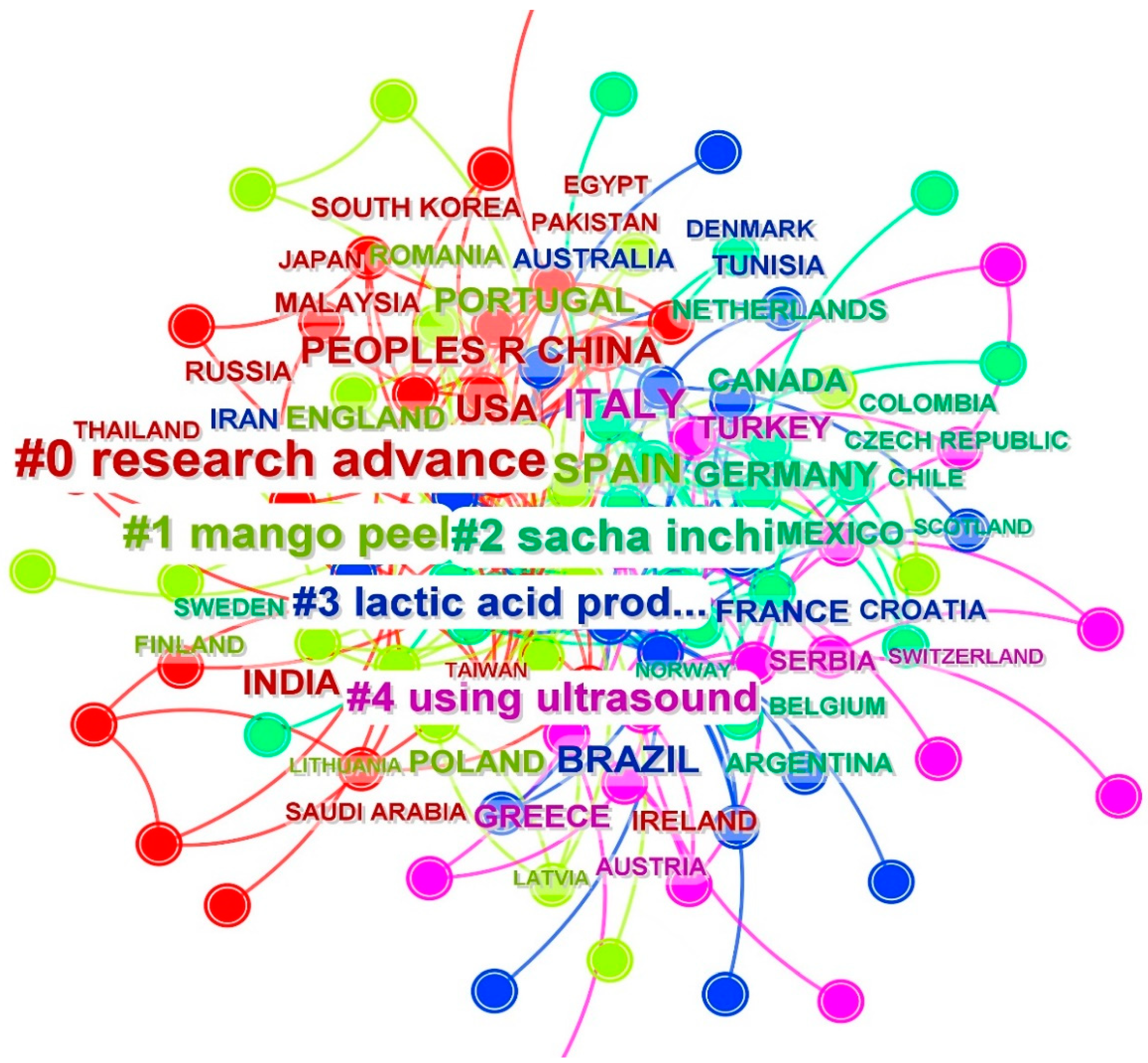
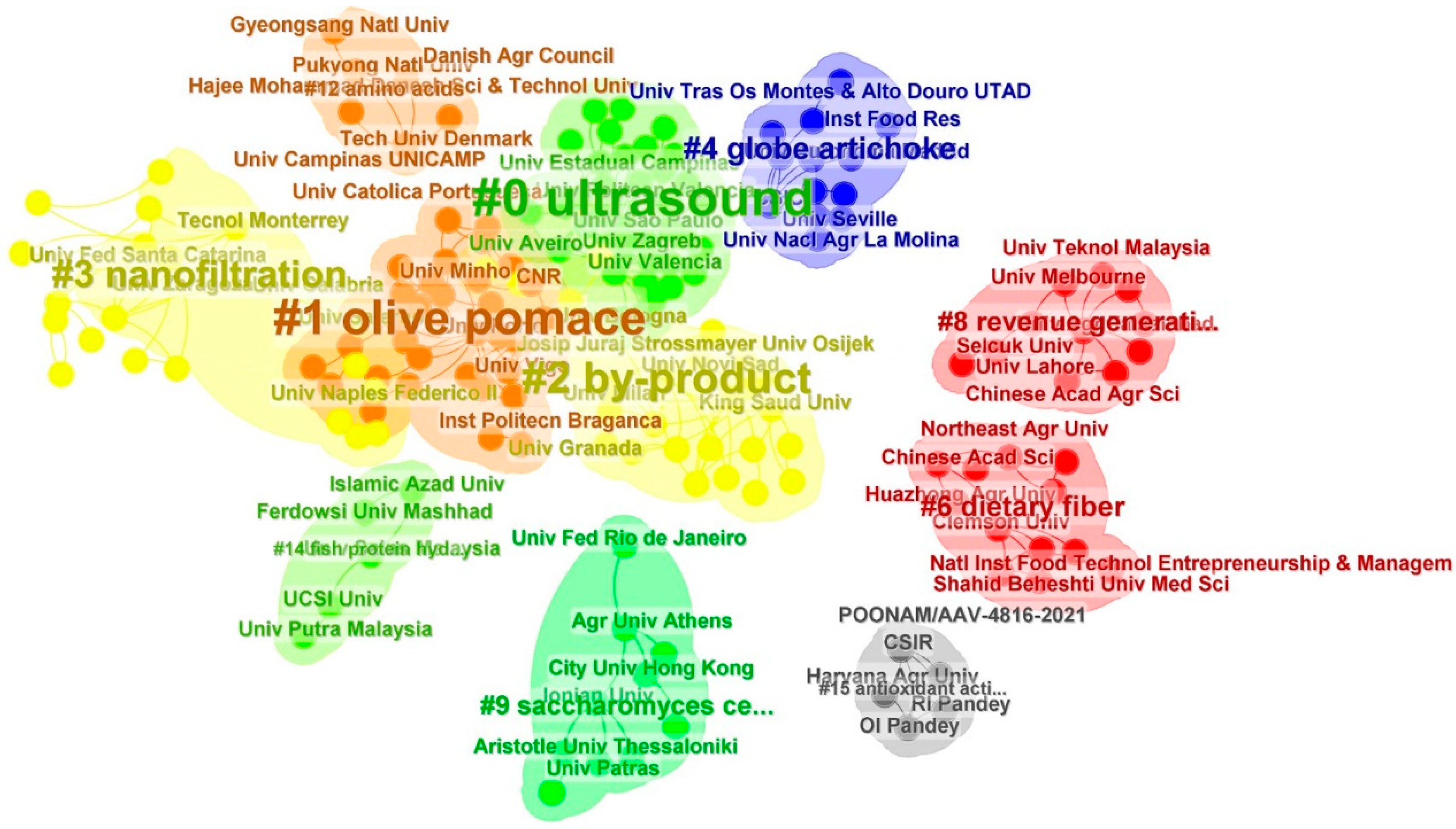
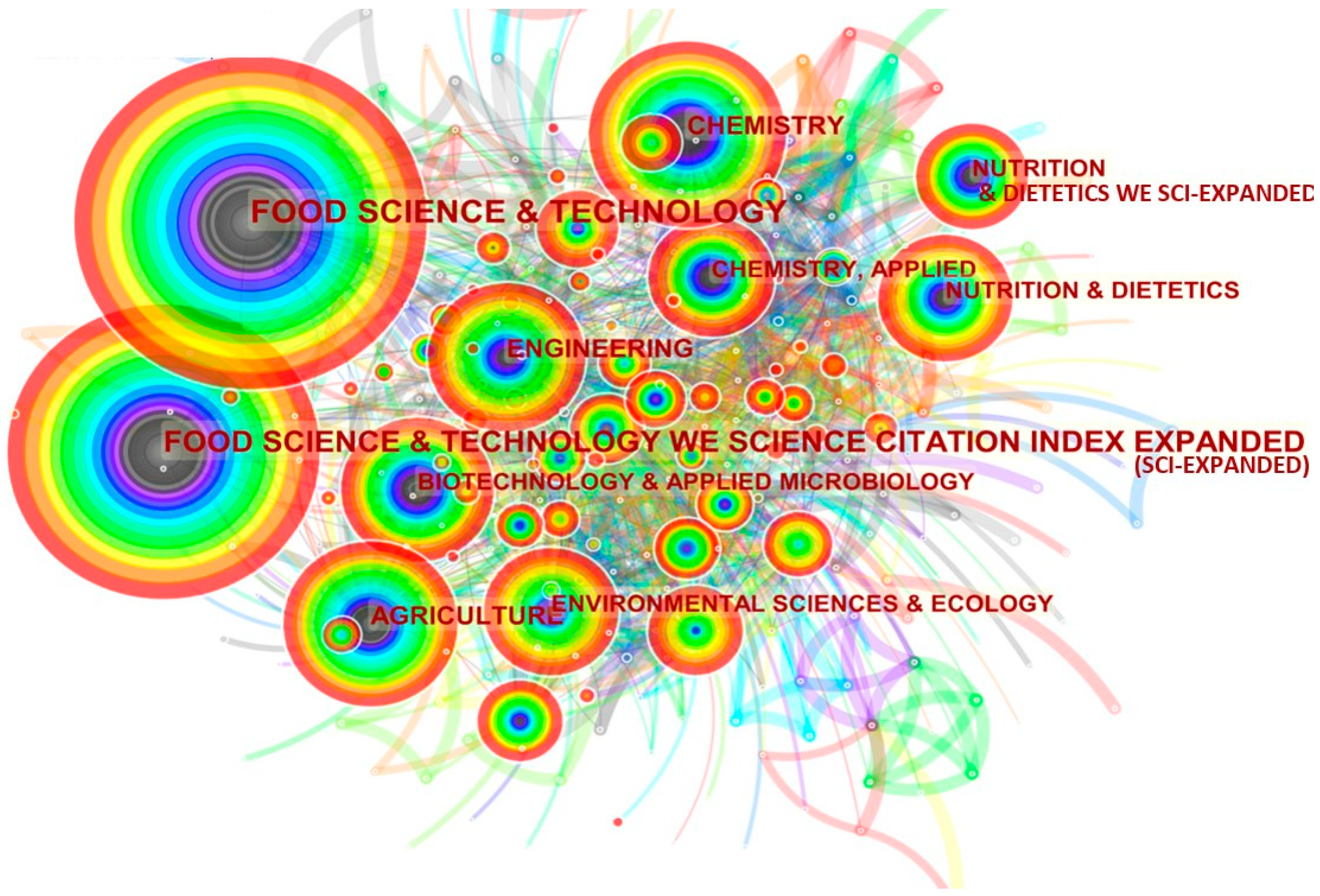
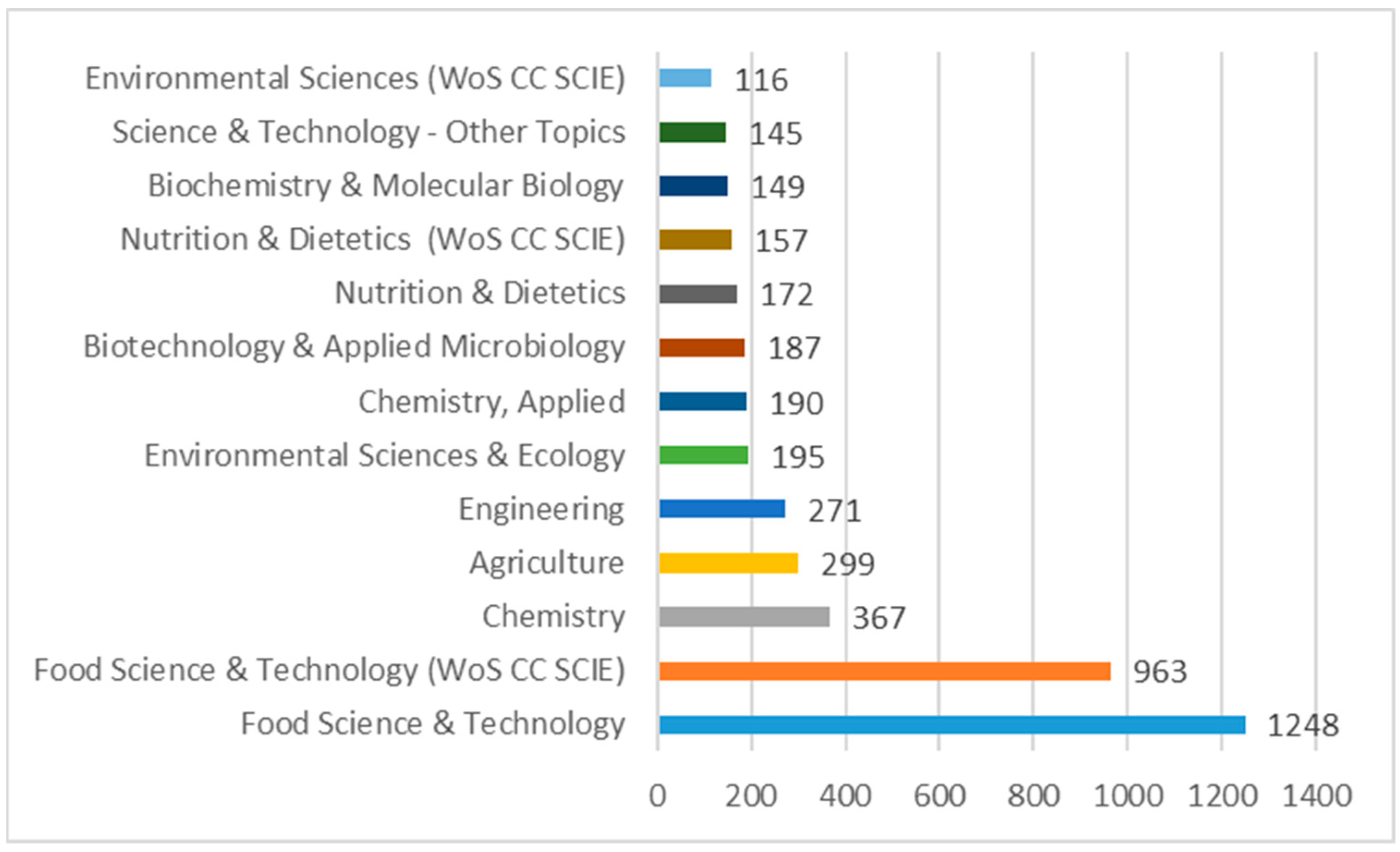
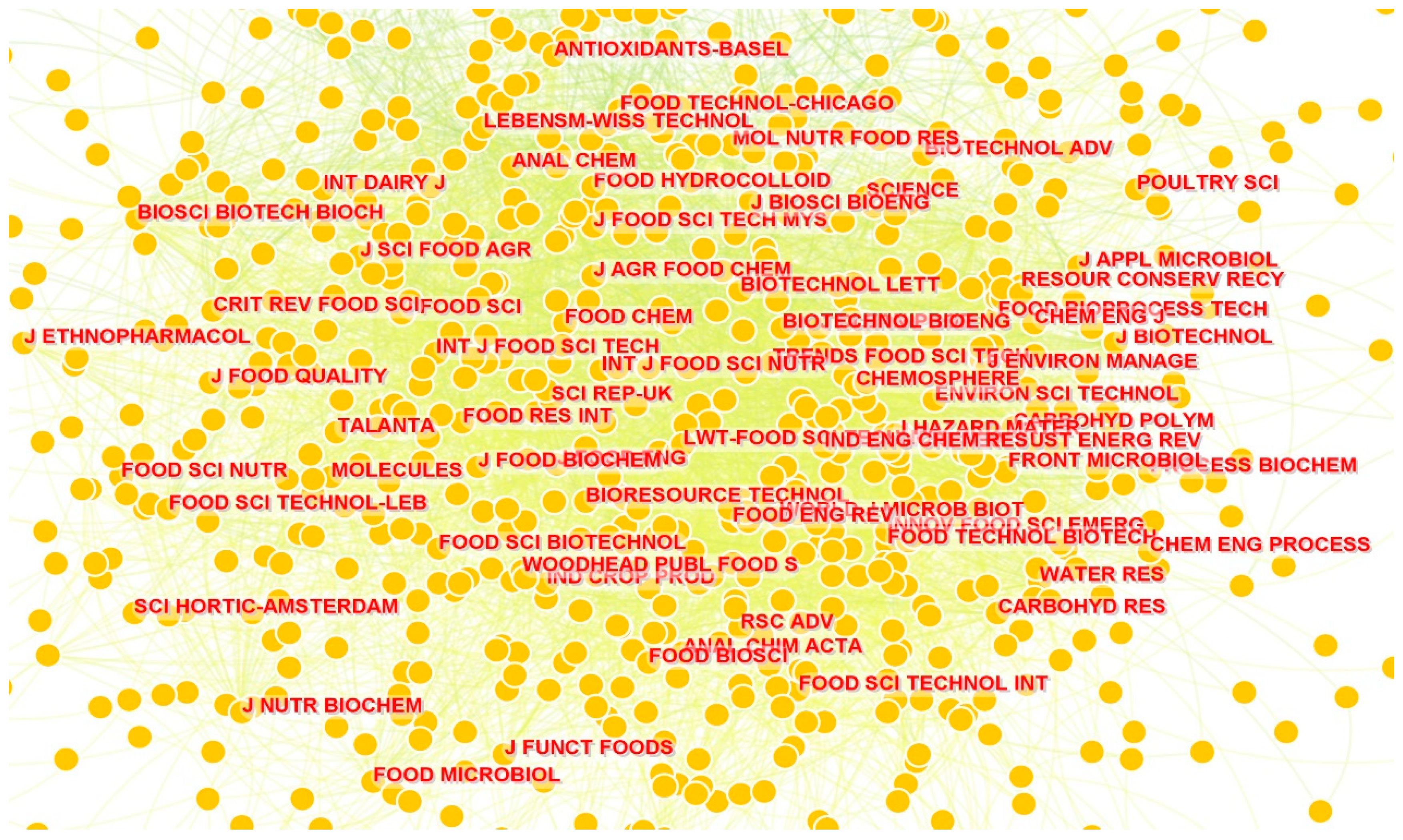
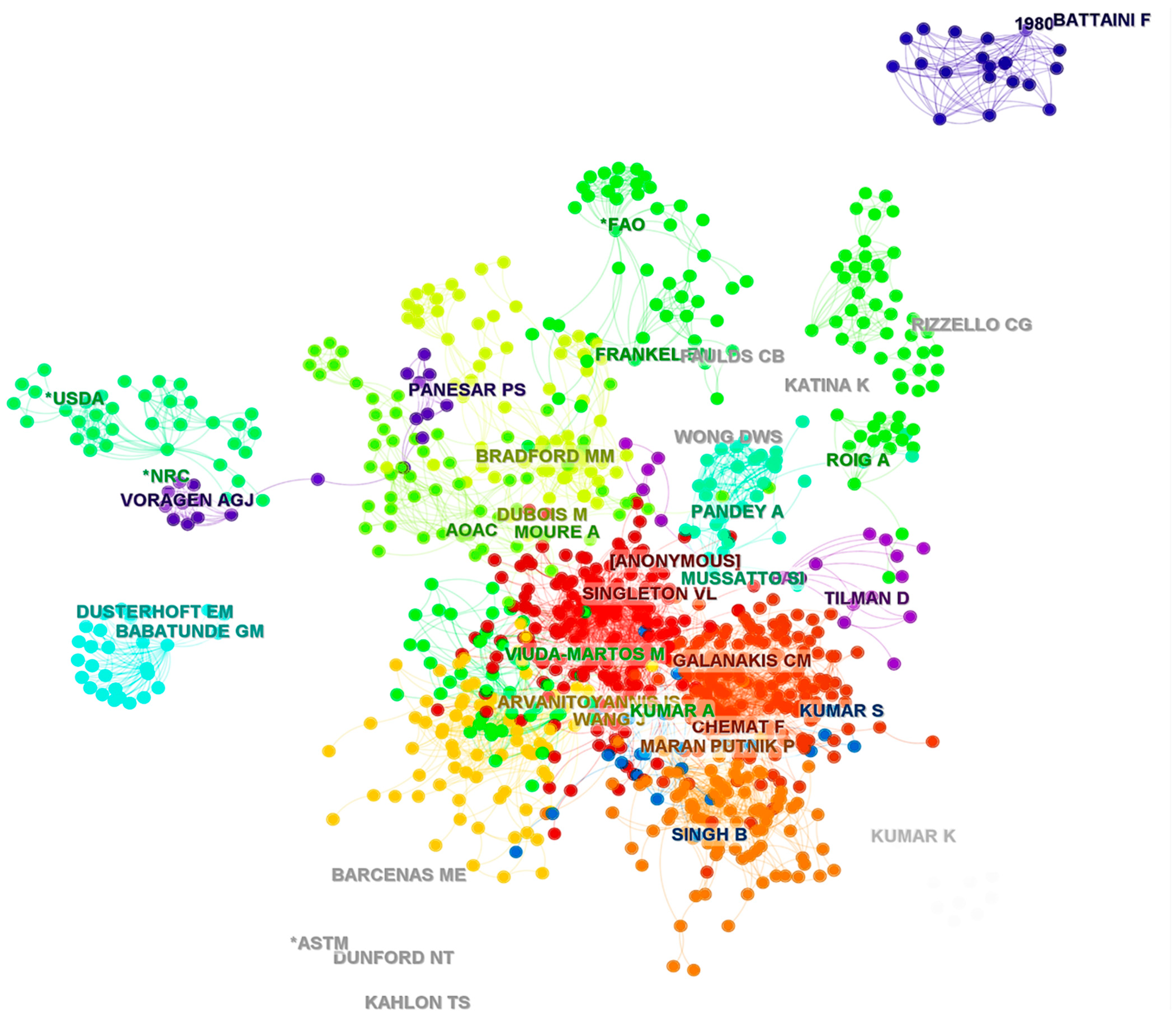

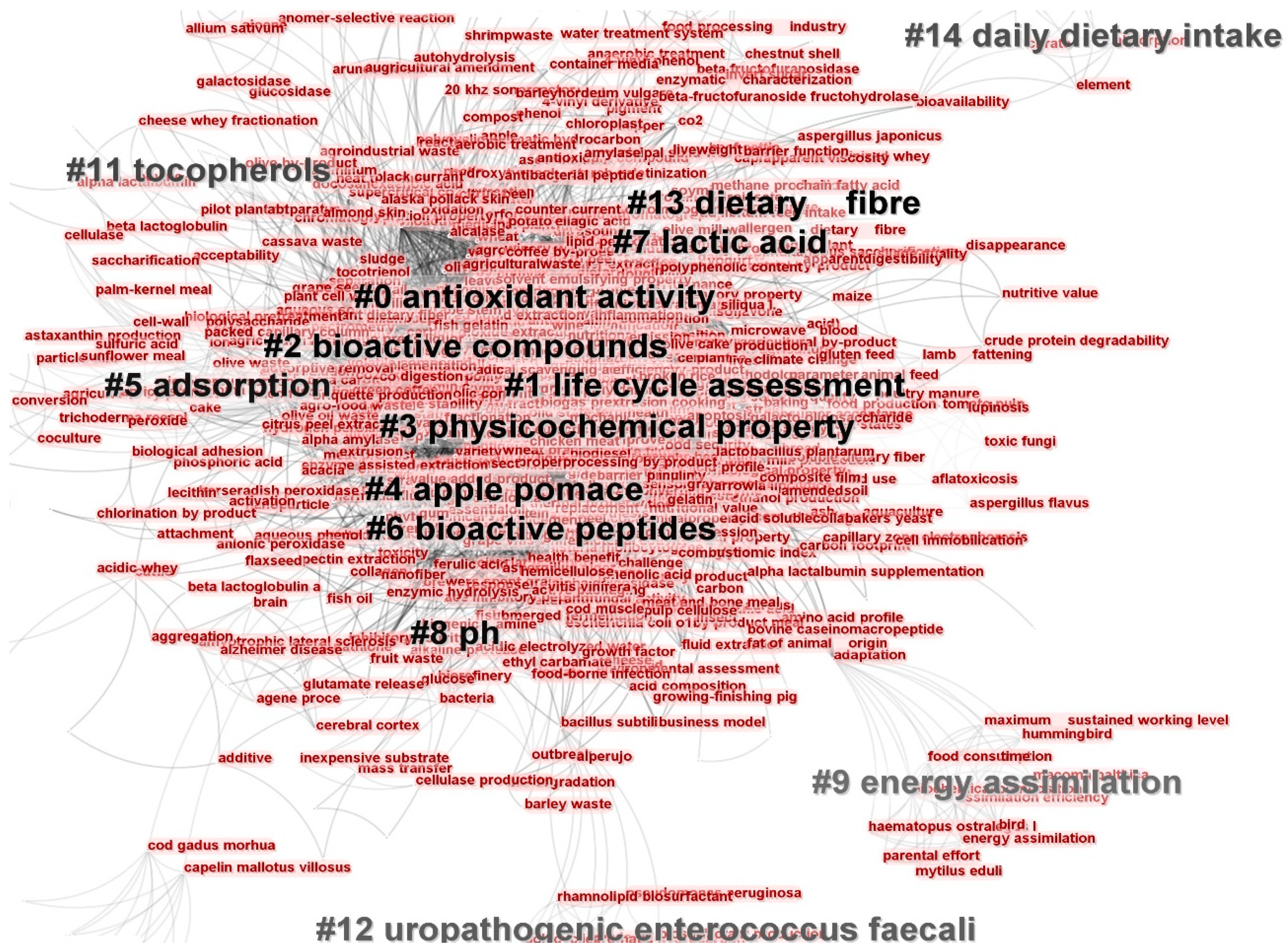
| Nr. | Number of Articles | Journal Title | IF 2021./Q | WoS Category |
|---|---|---|---|---|
| 1 | 238 | Journal of Food Processing and Preservation | 2.609/Q3 | Food Science & Technology |
| 2 | 69 | Foods | 5.561/Q1 | Food Science & Technology |
| 3 | 69 | Trends in Food Science & Technology | 16.002/Q1 | Food Science & Technology |
| 4 | 66 | Food Chemistry | 9.231/Q1 | Chemistry, Applied; Food Science & Technology; Nutrition & Dietetics |
| 5 | 51 | LWT—Food Science and Technology | 6.056/Q1 | Food Science & Technology |
| 6 | 45 | Molecules | 4.927/Q2 | Biochemistry & Molecular Biology; Chemistry, Multidisciplinary |
| 7 | 43 | Food Research International | 7.425/Q1 | Food Science & Technology |
| 8 | 37 | Journal of the Science of Food and Agriculture | 4.125/Q1; Q2; Q2 | Agriculture, Multidisciplinary; Chemistry, Applied; Food Science & Technology |
| 9 | 32 | Innovative Food Science & Emerging Technologies | 7.104/Q1 | Food Science & Technology |
| 10 | 31 | Critical Reviews in Food Science and Nutrition | 11.208/Q1 | Food Science & Technology |
| 11 | 31 | International Journal of Food Science and Technology | 3.612/Q2 | Food Science & Technology |
| Period | Keyword | Strength | Beginning | End | 1972–2021 |
|---|---|---|---|---|---|
| 1976–1999 | digestion | 1.27 | 1991 | 2002 |  |
| adsorption | 1.48 | 1993 | 2004 | ||
| bacteria | 1.3 | 1994 | 2006 | ||
| cultivation | 1.36 | 1997 | 2001 | ||
| cheese whey | 1.21 | 1998 | 2004 | ||
| energy | 1.75 | 1999 | 2003 | ||
| 2000–2009 | chromatography | 1.92 | 2000 | 2006 |  |
| beta carotene | 0.92 | 2001 | 2009 | ||
| acceptability | 1.19 | 2004 | 2013 | ||
| additive | 1.31 | 2006 | 2010 | ||
| alpha tocopherol | 1.54 | 2007 | 2012 | ||
| polysaccharide | 3.99 | 2008 | 2013 | ||
| 2010–2015 | fermentation | 3.6 | 2010 | 2012 |  |
| ascorbic acid | 3.56 | 2010 | 2014 | ||
| residue | 6.03 | 2012 | 2016 | ||
| fractionation | 2.83 | 2014 | 2016 | ||
| efficiency | 3.09 | 2015 | 2017 | ||
| enzymatic hydrolysis | 2.61 | 2015 | 2017 | ||
| 2016–2021 | response surface methodology | 5.45 | 2016 | 2018 |  |
| starch | 3.89 | 2017 | 2021 | ||
| pulsed electric field | 3.19 | 2017 | 2018 | ||
| whey protein | 3.27 | 2018 | 2021 | ||
| sensory property | 3.02 | 2019 | 2021 | ||
| antioxidant property | 3.64 | 2020 | 2021 |
Publisher’s Note: MDPI stays neutral with regard to jurisdictional claims in published maps and institutional affiliations. |
© 2022 by the authors. Licensee MDPI, Basel, Switzerland. This article is an open access article distributed under the terms and conditions of the Creative Commons Attribution (CC BY) license (https://creativecommons.org/licenses/by/4.0/).
Share and Cite
Hasenay, S.; Ačkar, Đ. Bibliometric Analysis of the Scientific Research of Food Industry By-Products in the Period 1976–2021. Sustainability 2022, 14, 16910. https://doi.org/10.3390/su142416910
Hasenay S, Ačkar Đ. Bibliometric Analysis of the Scientific Research of Food Industry By-Products in the Period 1976–2021. Sustainability. 2022; 14(24):16910. https://doi.org/10.3390/su142416910
Chicago/Turabian StyleHasenay, Sanda, and Đurđica Ačkar. 2022. "Bibliometric Analysis of the Scientific Research of Food Industry By-Products in the Period 1976–2021" Sustainability 14, no. 24: 16910. https://doi.org/10.3390/su142416910
APA StyleHasenay, S., & Ačkar, Đ. (2022). Bibliometric Analysis of the Scientific Research of Food Industry By-Products in the Period 1976–2021. Sustainability, 14(24), 16910. https://doi.org/10.3390/su142416910







